Lecture 6
advertisement
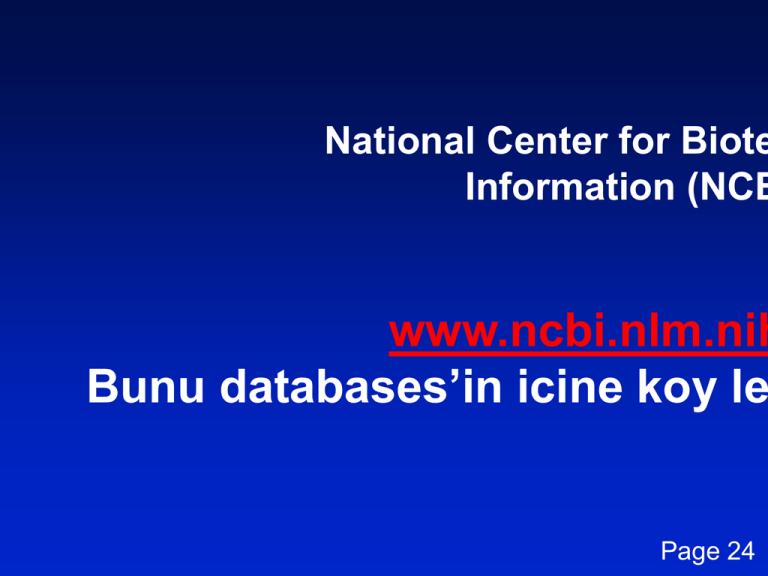
National Center for Biote Information (NCB www.ncbi.nlm.nih Bunu databases’in icine koy le Page 24 www.ncbi.nlm.nih.gov Fig. 2.5 Page 25 Fig. 2.5 Page 25 PubMed is… • National Library of Medicine's search service • 16 million citations in MEDLINE • links to participating online journals • PubMed tutorial (via “Education” on side bar) Page 24 Entrez integrates… • the scientific literature; • DNA and protein sequence databases; • 3D protein structure data; • population study data sets; • assemblies of complete genomes Page 24 Entrez is a search and retrieval system that integrates NCBI databases Page 24 BLAST is… • Basic Local Alignment Search Tool • NCBI's sequence similarity search tool • supports analysis of DNA and protein databases • 100,000 searches per day Page 25 OMIM is… •Online Mendelian Inheritance in Man •catalog of human genes and genetic disorders •edited by Dr. Victor McKusick, others at JHU Page 25 Cancer Chromosomes Contains cytogenetic, clinical, and reference information from integrated information from the NCI Mitelman Database of Chromosome Aberrations in Cancer, the NCI Recurrent Aberrations in Cancer database, and the NCI/NCBI SKY/M-FISH & CGH Database. CDD Conserved Domain Database, a collection of sequence alignments and profiles representing protein domains conserved in molecular evolution. Select 'Domains' from the Entrez pull down menu. CoreNucleotide Contains all nucleotide sequences not included in the EST or GSS subsets. 3D Domains Contains protein domains from the Entrez Structure database. EST A Nucleotide database subset that contains only Expressed Sequence Tag records. Gene Genes and associated information for a number of organisms in addition to and including human. Genome Genomes of over 1,200 organisms can be found in this database, representing both completely sequenced organisms and those for which sequencing is in progress. Genome Project A searchable collection of complete and incomplete (in-progress) large-scale sequencing, assembly, annotation, and mapping projects for cellular organisms. dbGaP Associated genotype and phenotype data. GENSAT Gene expression atlas of the mouse central nervous system. GEO Datasets Curated gene expression and molecular abundance DataSets from NCBI's Gene Expression Omnibus, a gene expression and hybridization array repository. GEO Profiles Individual gene expression and molecular abundance profiles assembled from the GEO repository. http://www.ncbi.nlm.nih.gov/About/tools/restable_mol.html Books is… • searchable resource of on-line books Page 26 TaxBrowser is… • browser for the major divisions of living organisms (archaea, bacteria, eukaryota, viruses) • taxonomy information such as genetic codes • molecular data on extinct organisms Page 26 Structure site includes… • Molecular Modelling Database (MMDB) • biopolymer structures obtained from the Protein Data Bank (PDB) • Cn3D (a 3D-structure viewer) • vector alignment search tool (VAST) Page 26 Accessing information on molecular sequences Page 26 Accession numbers are labels for sequences NCBI includes databases (such as GenBank) that contain information on DNA, RNA, or protein sequences. You may want to acquire information beginning with a query such as the name of a protein of interest, or the raw nucleotides comprising a DNA sequence of interest. DNA sequences and other molecular data are tagged with accession numbers that are used to identify a sequence or other record relevant to molecular data. Page 26 What is an accession number? An accession number is label that used to identify a sequence. It is a string of letters and/or numbers that corresponds to a molecular sequence. Examples (all for retinol-binding protein, RBP4): X02775 NT_030059 Rs7079946 GenBank genomic DNA sequence Genomic contig dbSNP (single nucleotide polymorphism) DNA N91759.1 NM_006744 An expressed sequence tag (1 of 170) RefSeq DNA sequence (from a transcript) RNA NP_007635 AAC02945 Q28369 1KT7 RefSeq protein GenBank protein SwissProt protein Protein Data Bank structure record protein Page 27 Four ways to access DNA and protein sequences [1] Entrez Gene with RefSeq [2] UniGene [3] European Bioinformatics Institute (EBI) and Ensembl (separate from NCBI) [4] ExPASy Sequence Retrieval System (separate from NCBI) Note: LocusLink at NCBI was recently retired. The third printing of the book has updated these sections (pages 27-31). Page 27 4 ways to access protein and DNA sequences [1] Entrez Gene with RefSeq Entrez Gene is a great starting point: it collects key information on each gene/protein from major databases. It covers all major organisms. RefSeq provides a curated, optimal accession number for each DNA (NM_006744) or protein (NP_007635) Page 27 From the NCBI home page, type “rbp4” and hit “Go” revised Fig. 2.7 Page 29 revised Fig. 2.7 Page 29 By applying limits, there are now just two entries Entrez Gene (top of page) Note that links to many other RBP4 database entries are available revised Fig. 2.8 Page 30 Entrez Gene (middle of page) Entrez Gene (bottom of page) Fig. 2.9 Page 32 Fig. 2.9 Page 32 Fig. 2.9 Page 32 FASTA format Fig. 2.10 Page 32 What is an accession number? An accession number is label that used to identify a sequence. It is a string of letters and/or numbers that corresponds to a molecular sequence. Examples (all for retinol-binding protein, RBP4): X02775 NT_030059 Rs7079946 GenBank genomic DNA sequence Genomic contig dbSNP (single nucleotide polymorphism) DNA N91759.1 NM_006744 An expressed sequence tag (1 of 170) RefSeq DNA sequence (from a transcript) RNA NP_007635 AAC02945 Q28369 1KT7 RefSeq protein GenBank protein SwissProt protein Protein Data Bank structure record protein Page 27 NCBI’s important RefSeq project: best representative sequences RefSeq (accessible via the main page of NCBI) provides an expertly curated accession number that corresponds to the most stable, agreed-upon “reference” version of a sequence. RefSeq identifiers include the following formats: Complete genome Complete chromosome Genomic contig mRNA (DNA format) Protein NC_###### NC_###### NT_###### NM_###### e.g. NM_006744 NP_###### e.g. NP_006735 Page 29-30 NCBI’s RefSeq project: accession for genomic, mRNA, protein sequences Accession AC_123456 AP_123456 NC_123456 NG_123456 NM_123456 NM_123456789 NP_123456 NP_123456789 NR_123456 NT_123456 NW_123456 NZ_ABCD12345678 XM_123456 XP_123456 XR_123456 YP_123456 ZP_12345678 Molecule Genomic Protein Genomic Genomic mRNA mRNA Protein Protein RNA Genomic Genomic Genomic mRNA Protein RNA Protein Protein Method Mixed Mixed Mixed Mixed Mixed Mixed Mixed Curation Mixed Automated Automated Automated Automated Automated Automated Auto. & Curated Automated Note Alternate complete genomic Protein products; alternate Complete genomic molecules Incomplete genomic regions Transcript products; mRNA Transcript products; 9-digit Protein products; Protein products; 9-digit Non-coding transcripts Genomic assemblies Genomic assemblies Whole genome shotgun data Transcript products Protein products Transcript products Protein products Protein products Four ways to access DNA and protein sequences [1] Entrez Gene with RefSeq [2] UniGene [3] European Bioinformatics Institute (EBI) and Ensembl (separate from NCBI) [4] ExPASy Sequence Retrieval System (separate from NCBI) Page 31 DNA RNA protein complementary DNA (cDNA) UniGene Fig. 2.3 Page 23 UniGene: unique genes via ESTs • Find UniGene at NCBI: www.ncbi.nlm.nih.gov/UniGene • UniGene clusters contain many expressed sequence tags (ESTs), which are DNA sequences (typically 500 base pairs in length) corresponding to the mRNA from an expressed gene. ESTs are sequenced from a complementary DNA (cDNA) library. • UniGene data come from many cDNA libraries. Thus, when you look up a gene in UniGene you get information on its abundance and its regional distribution. Pages 20-21 Cluster sizes in UniGene This is a gene with 1 EST associated; the cluster size is 1 Fig. 2.3 Page 23 Cluster sizes in UniGene This is a gene with 10 ESTs associated; the cluster size is 10 Cluster sizes in UniGene (human) Cluster size (ESTs) 1 2 3-4 5-8 9-16 17-32 500-1000 2000-4000 8000-16,000 16,000-30,000 UniGene build 194, 8/06 Number of clusters 42,800 6,500 6,500 5,400 4,100 3,300 2,128 233 21 8 UniGene: unique genes via ESTs Conclusion: UniGene is a useful tool to look up information about expressed genes. UniGene displays information about the abundance of a transcript (expressed gene), as well as its regional distribution of expression (e.g. brain vs. liver). We will discuss UniGene further later (gene expression). Page 31 Five ways to access DNA and protein sequences [1] Entrez Gene with RefSeq [2] UniGene [3] European Bioinformatics Institute (EBI) and Ensembl (separate from NCBI) [4] ExPASy Sequence Retrieval System (separate from NCBI) Page 31 Ensembl to access protein and DNA sequences Try Ensembl at www.ensembl.org for a premier human genome web browser. We will encounter Ensembl as we study the human genome, BLAST, and other topics. click human enter RBP4 Five ways to access DNA and protein sequences [1] Entrez Gene with RefSeq [2] UniGene [3] European Bioinformatics Institute (EBI) and Ensembl (separate from NCBI) [4] ExPASy Sequence Retrieval System (separate from NCBI) Page 33 ExPASy to access protein and DNA sequences ExPASy sequence retrieval system (ExPASy = Expert Protein Analysis System) Visit http://www.expasy.ch/ Page 33 Fig. 2.11 Page 33 Example of how to access sequence data: HIV-1 pol There are many possible approaches. Begin at the main page of NCBI, and type an Entrez query: hiv-1 pol Page 34 Searching for HIV-1 pol: Following the “genome” link yields a manageable three results Page 34 Example of how to access sequence data: HIV-1 pol For the Entrez query: hiv-1 pol there are about 40,000 nucleotide or protein records (and >100,000 records for a search for “hiv-1”), but these can easily be reduced in two easy steps: --specify the organism, e.g. hiv-1[organism] --limit the output to RefSeq! Page 34 over 100,000 nucleotide entries for HIV-1 only 1 RefSeq Examples of how to access sequence data: histone query for “histone” # results protein records RefSeq entries 21847 7544 RefSeq (limit to human) NOT deacetylase 1108 697 At this point, select a reasonable candidate (e.g. histone 2, H4) and follow its link to Entrez Gene. There, you can confirm you have the right gene/protein. 8-12-06 Access to Biomedical Literature Page 35 PubMed at NCBI to find literature information PubMed is the NCBI gateway to MEDLINE. MEDLINE contains bibliographic citations and author abstracts from over 4,600 journals published in the United States and in 70 foreign countries. It has >14 million records dating back to 1966. Page 35 MeSH is the acronym for "Medical Subject Headings." MeSH is the list of the vocabulary terms used for subject analysis of biomedical literature at NLM. MeSH vocabulary is used for indexing journal articles for MEDLINE. The MeSH controlled vocabulary imposes uniformity and consistency to the indexing of biomedical literature. Page 35 PubMed search strategies Try the tutorial (“education” on the left sidebar) Use boolean queries (capitalize AND, OR, NOT) lipocalin AND disease Try using “limits” Try “Links” to find Entrez information and external resources Obtain articles on-line via Welch Medical Library (and download pdf files): http://www.welch.jhu.edu/ Page 35 1 AND 2 1 2 lipocalin AND disease (60 results) 1 OR 2 1 2 lipocalin OR disease (1,650,000 results) 1 NOT 2 1 2 lipocalin NOT disease (530 results) Fig. 2.12 Page 34 8/04 Article contents: “globin” is present “globin” is absent Search result: “globin” is found true positive false positive (article does not discuss globins) “globin” is not found false negative (article discusses globins) true negative 8/06 WelchWeb is available at http://www.welch.jhu.edu http://www.welch.jhu.edu Brian Brown (bbrown20@jhmi.edu) and Carrie Iwema (iwema@jhmi.edu) are the Welch Medical Library liasons to the basic sciences
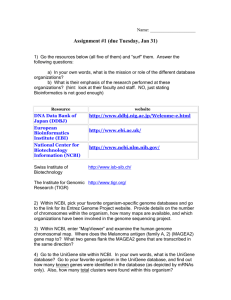

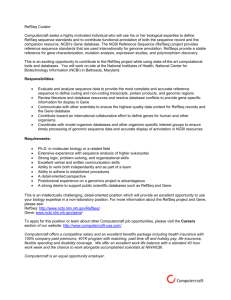
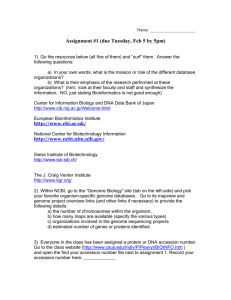
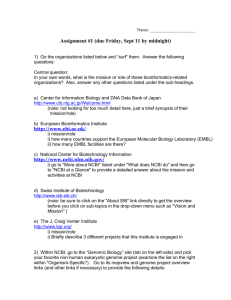
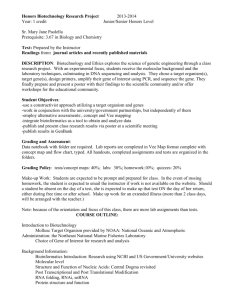
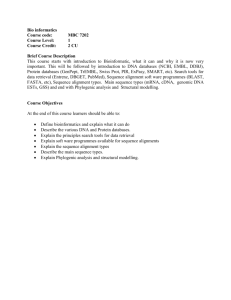
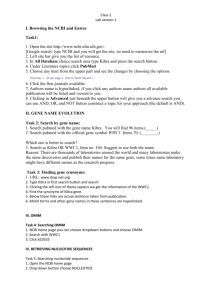

![Instructions for BLAST [alublast]](http://s3.studylib.net/store/data/007906582_2-a3f8cf4aeaa62a4a55316a3a3e74e798-300x300.png)